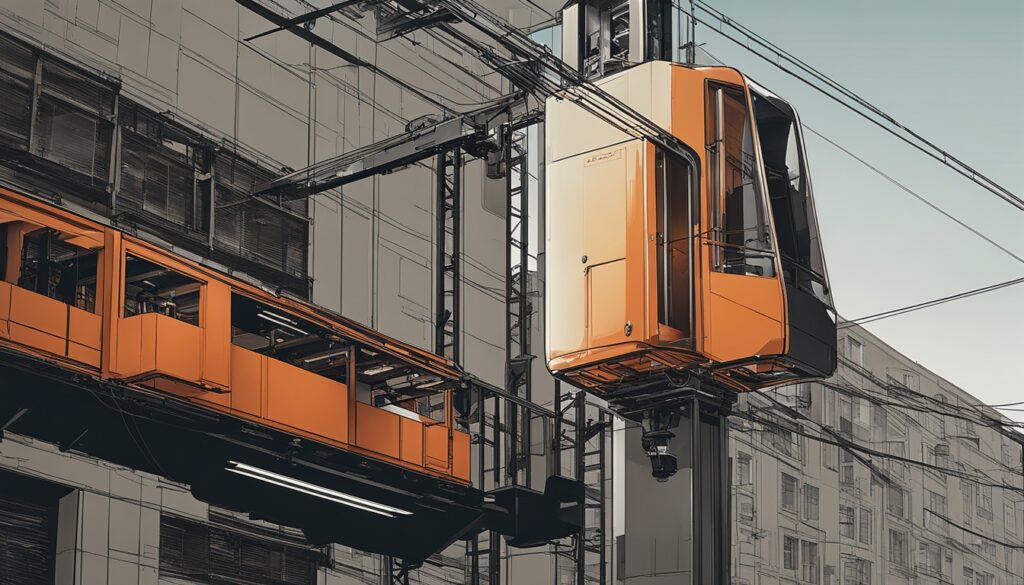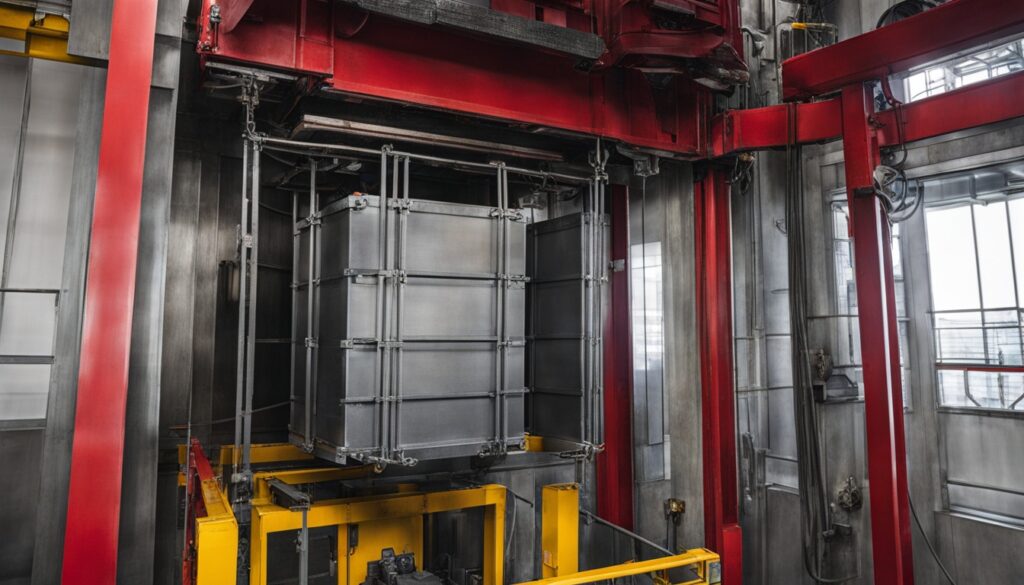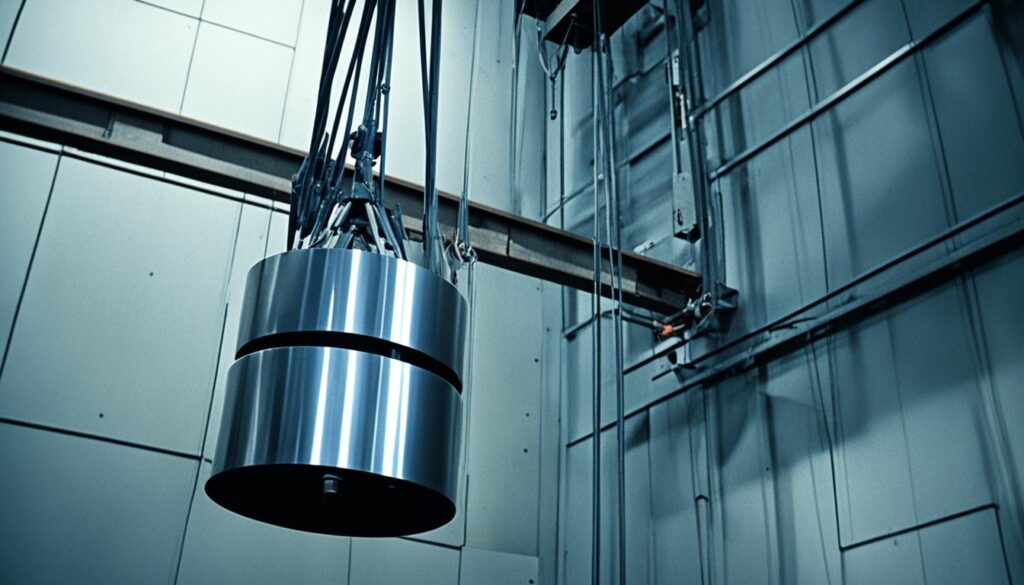In today’s buildings, having elevators that work well and safely is key. The elevator counterweight is a vital part of this. We know how important counterweights are for making elevators move smoothly and reliably. They help keep buildings safe and use less energy.
Key Takeaways
- Elevator counterweights are essential for balancing the weight of the elevator car, enabling smooth and reliable movement.
- Counterweights help minimize energy consumption by allowing the use of smaller, more efficient motors.
- Proper design and installation of counterweights are crucial for the overall safety and performance of elevator systems.
- Advancements in counterweight technology have led to improved energy efficiency and reliability in modern elevator systems.
- Regular maintenance and inspection of counterweights are necessary to ensure the continued safe operation of elevators.
Understanding the Role of Counterweights
Elevator counterweights are key to making lifts work safely and efficiently. They balance out the weight of the elevator and what’s inside. This balance means less energy is needed to move the elevator.
Balancing the Load for Smooth Operation
Counterweights spread the load evenly, making the elevator move smoothly. This balanced system cuts down on strain on the drive parts. It also makes the ride smoother for people inside. Plus, it helps the elevator use less energy, thanks to smaller, energy-efficient motors.
Minimizing Energy Consumption
The counterweight function is vital for elevator load balancing. It makes energy-efficient elevators possible. By balancing the weight, the elevator needs less energy to go up and down. This is key to making elevators more sustainable and cost-effective.
| Counterweight Function | Elevator Load Balancing | Energy-Efficient Elevators | Elevator Mechanics |
|---|---|---|---|
| Counteracts the weight of the elevator car and its contents, creating a balanced system | Evenly distributes the load, reducing strain on the drive system and ensuring smooth operation | Enables the use of smaller, more energy-efficient motors, contributing to overall sustainability | Crucial aspect of modern elevator systems, ensuring safe and efficient operation |

“Counterweights are the unsung heroes of the elevator industry, quietly ensuring the smooth and efficient operation of these essential transport systems.”
Elevator Counterweight: Essential for Safe Lift Systems
Elevator counterweights are key to keeping lift systems safe and reliable. They help keep the elevator car stable and balanced. This reduces the risk of sudden drops that could be dangerous for passengers.
Counterweights are a must-have in elevator design. They meet safety rules and building codes, making lifts safe and dependable. They spread out the weight of the elevator car for smooth and controlled moves.
Counterweights are vital because they balance the elevator car’s weight with passengers inside. This keeps the lift safe and efficient. It also cuts down on energy use by making the system work better.
Following building code requirements shows how crucial counterweights are. These rules protect people and make sure lifts are strong. So, counterweights are a key part of safe elevator systems.
| Counterweight Importance | Benefits |
|---|---|
| Maintains stability and balance of elevator car | Reduces risk of sudden movements or uncontrolled descent |
| Helps distribute weight of elevator car and passengers | Enables smooth and controlled operation |
| Minimizes energy consumption | Optimizes system efficiency |
| Required by building codes and safety regulations | Ensures public safety and structural integrity of lift systems |

In short, elevator counterweights are vital for safe and reliable lifts. They protect passengers and keep buildings strong. They’re a key part of elevator design and meet strict safety rules.
Counterweight Design Considerations
Designing an effective elevator counterweight system is a detailed process. It involves many factors for safe and efficient operation. The weight, materials, and construction of the counterweight are key to the lift system’s performance.
Weight Calculations and Safety Factors
Finding the right counterweight mass is crucial. Engineers must look at the elevator car’s weight, its capacity, and other factors. This balance is key for smooth operation and safety.
Materials and Construction
The materials and how the counterweight is made matter a lot. It must handle the forces of moving up and down. Steel and cast iron are often used for their strength, resistance to rust, and safety. The design and build of the counterweight help it last longer and need less upkeep.
| Counterweight Design Factors | Considerations |
|---|---|
| Weight Calculations | Determining the optimal counterweight mass based on elevator car weight, capacity, and other factors |
| Safety Standards | Ensuring the counterweight meets or exceeds industry safety standards for strength, durability, and reliability |
| Materials and Construction | Selecting durable materials and designing a robust counterweight construction to withstand operational forces |
“The design of the elevator counterweight is a critical component in ensuring the overall safety and reliability of the lift system.”
Installation and Maintenance
Installing and maintaining elevator counterweights is key for safe and reliable lift systems. Trained techs must follow strict protocols to make sure the counterweight is balanced and secure. Regular checks and services help spot and fix any problems early.
Proper Installation Techniques
Installing elevator counterweights needs special skills and care. It’s vital to follow the maker’s rules and local building codes for safety. Technicians must get the counterweight’s weight and position right for smooth and efficient lifts.
- Precise weight calculations and safety factor considerations
- Proper securing and alignment of the counterweight assembly
- Compliance with local regulations and industry best practices
Regular maintenance procedures, like safety inspections and elevator service, are key. They help spot and fix problems early. Keeping the counterweight in good shape and making sure everything works right keeps the elevator safe and reliable.
| Maintenance Task | Frequency | Purpose |
|---|---|---|
| Counterweight lubrication | Quarterly | Prevent wear and ensure smooth operation |
| Counterweight alignment check | Biannually | Ensure proper balance and weight distribution |
| Counterweight safety inspection | Annually | Identify any structural or mechanical issues |
Following best practices for counterweight installation and upkeep keeps elevator systems safe and reliable. This means a smooth ride for passengers and less chance of sudden breakdowns or expensive fixes.
Advancements in Counterweight Technology
The elevator industry is always changing, and so is the technology in counterweights. New research and development have brought us better materials, designs, and ways to connect with other elevator parts. This has given building owners and operators many benefits.
One big step forward is using lightweight yet durable materials. Things like high-strength alloys and composites are now common. They make the counterweight system lighter and use less energy to move the elevator car up and down.
Also, new counterweight designs make elevators safer and work better. These designs have integrated sensor systems that check the counterweight’s position, tension, and balance all the time. This gives the elevator’s control system real-time data. It helps fix problems fast, making sure the ride is safe and smooth for everyone.
Counterweight technology has also gotten better at working with other elevator parts. Regenerative braking systems are a great example. They use the energy from the elevator going down to power the building, making the system more energy efficient.
These counterweight innovations, along with better elevator technology and safety enhancements, have created a new kind of elevator. They are more reliable, save money, and are better for the environment than ever before.
Conclusion
Elevator counterweights are key to modern lift systems. They ensure safety, efficiency, and smooth operation. By balancing the elevator car’s weight, they keep things stable and reduce strain on the motors. This makes it possible to use smaller, more efficient motors.
Counterweights are vital for safe lift systems. They help keep elevators stable and controlled, lowering the risk of accidents. They also make elevator systems more energy efficient, which is good for the planet.
As elevator technology gets better, counterweights will keep evolving. They will meet the needs of modern buildings. Keeping an eye on the importance of elevator counterweights will help make elevators safe and efficient. This will make buildings better for everyone who uses them.
FAQ
What is the role of elevator counterweights in modern buildings?
Elevator counterweights are key to making lifts work safely and efficiently. They balance the elevator car’s weight for smooth movement. This also helps save energy.
How do counterweights help in the overall safety of lift systems?
Counterweights are vital for lift safety. They keep the elevator car stable and balanced. This reduces the risk of sudden drops or uncontrolled falls, keeping passengers safe.
What factors are considered in the design of elevator counterweights?
Designing elevator counterweights requires careful calculations. Engineers must figure out the right weight based on the elevator car’s size, capacity, and other factors. This ensures the best balance.
How important is the proper installation and maintenance of elevator counterweights?
Proper installation and maintenance of elevator counterweights are crucial. Trained technicians must ensure the counterweight is balanced and secure. Regular checks and services are needed to fix any problems or wear.
What advancements have been made in elevator counterweight technology?
Elevator technology has grown, so has counterweight tech. New materials and designs have been developed. This leads to better energy use, safety, and performance.


